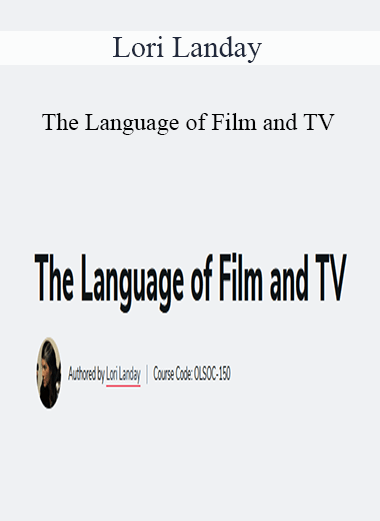Lori Landay – The Language of Film and TV
$1,250.00 Original price was: $1,250.00.$250.00Current price is: $250.00.
Digital Download: You will receive a download link via your order email after successful payment.
As a composer or musician in the film and television industries, it’s essential to be able to communicate effectively with directors, producers, and others involved in the production of these media.
The Language of Film and TV
As a composer or musician in the film and television industries, it’s essential to be able to communicate effectively with directors, producers, and others involved in the production of these media. The Language of Film and TV course is designed to give you a thorough understanding of film and television and, specifically, how they make meaning beyond their stories and characters.
The course guides you through the history of film and television and the crucial concepts about the language they use to reach their audiences – a language that includes camera, frame composition, lighting, production design, acting-styles, editing, dialogue, plot, genre, themes, sound, and point of view. You’ll learn about mise-en-scène, cinematography, and editing, so that you are well versed in the design and visual elements of film and television.
The course begins with an overview of the origins of cinema, exploring the contributions of Edison, the Lumière brothers, and Méliès, and then moves through the silent era into sound and the studio system, examining the role of narrative, acting, and sound and how they evolved. It then explores the emergence of television and how it became a part of everyday life.
You’ll also learn about documentary, experimental, and animated film, and examine how digital technology is changing film, television, and media today. Throughout the course, you will screen and analyze such films as The Great Train Robbery, It, The Crowd, Bringing Up Baby, Double Indemnity, North by Northwest, Citizen Kane, Singin’ in the Rain, Apocalypse Now, Raging Bull, Goodfellas, and others. You will also choose films from the American Film Institute’s 100 Years 100 Movies list and other sources for analysis. Television series include I Love Lucy and currently airing series.
The goal of the course is to provide you with the skills to interpret and analyze film and television, including their historical, stylistic, and narrative contexts, in order to better prepare you for working in these industries.
By the end of the course, you will be able to:
- Identify and define terms associated with the film and television industry
- Understand the historical development of film and television and the cultural contexts in which they evolved
- Explain how film and television make visual and narrative meaning through a language that includes camera, frame composition, lighting, production design, acting-styles, editing, dialogue, plot, genre, themes, sound, and point of view•
- Interpret and analyze film and television, with emphasis on the cultural contexts of filmmaking, television production, and film and television meaning
- Better communicate with directors and producers in the media industries
Syllabus
Lesson 1 Classical Hollywood Cinema
Lesson 2 Early Cinema: From Muybridge to The Great Train Robbery
Lesson 3 Silent Film
Lesson 4 Coming of Sound in Film in the 1930-40s
Lesson 5 Film Sound
Lesson 6 Network Television
Lesson 7 Documentary, Experimental, and Animated Film and Television
Lesson 8 Mise-en-Scene: What Is in the Shot
Lesson 9 Cinematography: Photographic Qualities of the Shot
Lesson 10 Editing
Lesson 11 Television in the Cable and Internet Eras
Lesson 12 The Digital Era
.rTableRow { display: table-row; }
.rTableHeading { background-color: #ddd; display: table-header-group; }
.rTableCell, .rTableHead { display: table-cell; padding: 3px 10px; border: 1px solid #999999; }
.rTableHeading { display: table-header-group; background-color: #ddd; font-weight: bold; }
.rTableFoot { display: table-footer-group; font-weight: bold; background-color: #ddd; }
.rTableBody { display: table-row-group; }
.rTable { display: table; width: 100%;}
.rTableRow { display: table-row; }
.rTableHeading { background-color: #ddd; display: table-header-group; }
.rTableCell, .rTableHead { display: table-cell; padding: 3px 10px; border: 1px solid #999999; }
.rTableHeading { display: table-header-group; background-color: #ddd; font-weight: bold; }
.rTableFoot { display: table-footer-group; font-weight: bold; background-color: #ddd; }
.rTableBody { display: table-row-group; }
Get Download Lori Landay – The Language of Film and TV at imcourse.biz today!
Delivery Method
– After your purchase, you’ll see a View your orders link which goes to the Downloads page. Here, you can download all the files associated with your order.
– Downloads are available once your payment is confirmed, we’ll also send you a download notification email separate from any transaction notification emails you receive from imcourse.biz.
– Since it is a digital copy, our suggestion is to download and save it to your hard drive. In case the link is broken for any reason, please contact us and we will resend the new download link.
– If you cannot find the download link, please don’t worry about that. We will update and notify you as soon as possible at 8:00 AM – 8:00 PM (UTC+8).
Thank You For Shopping With Us!
Be the first to review “Lori Landay – The Language of Film and TV” Cancel reply
Login





9 reviews for Lori Landay – The Language of Film and TV
There are no reviews yet.